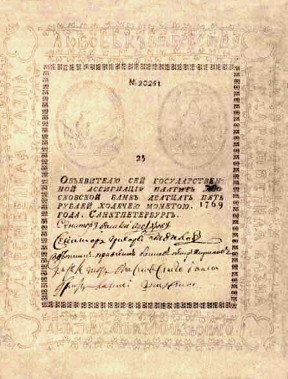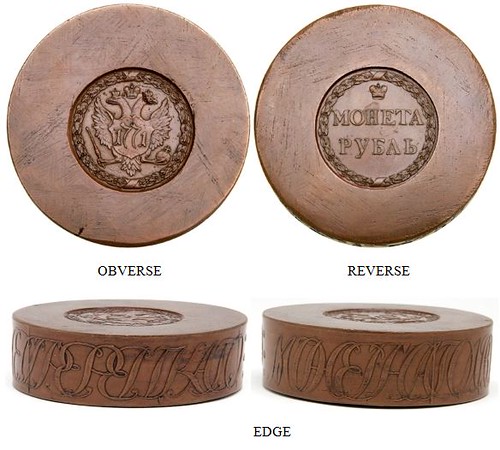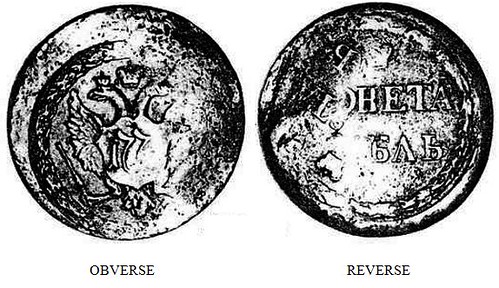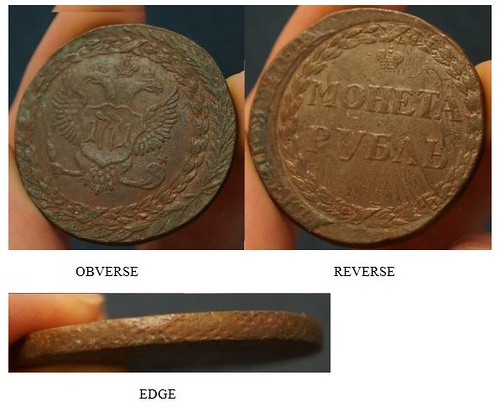
PREV ARTICLE
NEXT ARTICLE
FULL ISSUE
PREV FULL ISSUE
THE SESTRORETSK AND PUGACHEV RUBLES
Steve Bishop submitted this article about a couple of interesting recent finds. Thanks! -Editor
THE STRANGE TALE OF THE SESTRORETSK AND PUGACHEV RUBLES The advent of eBay and other online auction sites has greatly expanded the availability of rare and unusual numismatic items. I have an interest in the copper coinage of 19th century Russia, especially the coins issued under the reigns of Peter III, limited to 1762 and Catherine II (The Great), covering 1762-96. There are numerous instances of coins being struck over coins of earlier rulers, of which I have made a particular specialty. The presence of eBay has allowed me to purchase a number of nice coins, some of them directly from Russia. I have two pieces in my collection that have been struck from the dies of the same design. One is renowned as the world’s largest round copper coin, and the other is a famous fantasy piece struck especially for collectors. Both are copper, but that is where their commonality ends. THE SESTRORETSK RUBLE

25 RUBLE ASSIGNAT ISSUED IN 1769 These were to be backed by and fully exchangeable for copper currency. Since it was surmised that not too many holders of the paper assignats would ask to exchange them for the large and heavy copper coins, and the mints could not keep up with the demand for 5 kopeck pieces, the largest copper coin minted at the time, it was proposed that a copper ruble could be more efficiently produced than twenty 5 kopeck pieces. Thus, a law was enacted in 1770 calling for the issue of copper rubles. Production was to take place at the Military Ordnance Works at Sestroretsk (sometimes spelled Cestroretsk) near St. Petersburg. Completely new machinery was constructed to make the massive 1000 gram planchets. Because of the thickness of the required planchets, it was decided to saw them from copper rods of the appropriate diameter. That proved to be a problem: the machine had 25 saws that each had to be water-cooled. Despite the cooling water, the saws soon overheated and produced planchets of impossible forms. An alternate procedure whereby planchets were cast, then lathed to the needed specifications was tried. This proved to be too expensive. After 8 years of experimentation and frustration, the few original test samples were sent to the Senate and the dies were stored at the St. Petersburg Mint. Two specimens date 1770 were recorded, one of which is housed in the Hermitage Museum in St. Petersburg. Showing signs of mutilation by a sharp instrument, it is 72.5 mm in diameter, 26 mm thick, and weighs only 926 grams, short of the weight intended. The second recorded 1770 specimen is missing, perhaps to be discovered someday by a lucky numismatist. Three original specimens dated 1771 are known, two in the Hermitage and one in the Smithsonian Museum of American History, which houses the extensive collection of Russian coins belonging to the Grand Duke Georgii Michailovitch, nephew of Tsar Alexander II. One of the 1771 pieces is similar to the 1770 piece, weighing in at 934 grams. The second weighs 1009.3 grams, very close to the intended weight. The third is unique, being struck from a planchet 101 mm in diameter and 15 mm thick, weighing 1048.9 grams, resulting from an attempt to solve the production problems by punching the planchets from 15 mm plate. A number of novodels exist of the 1771 pieces, struck from original dies and remade edge collars in the 1840’s and 1850’s, having been ordered by finance minister Kankhrin in 1836. These novodels constitute the only examples struck by the Russian government available to collectors, since all of the originals reside in museums. As many as 50 of these restrikes may exist, and sell in the neighborhood of $50,000 when they infrequently become available. The Sestroretsk ruble I have obtained is a modern copy dated 1770 I acquired from a Russian eBay seller. It weighs 1065 grams, is 78 mm in diameter, and 25 mm thick. 
I have found an auction occurrence for a 1771 novodel, lot 1868 from the Goldberg Pre-Long Beach Sale 31, August 22, 2005. Catalogued as Br-317, edge type-2; Bitkin-880. Novodel. 1030.6 grams. 75.9 mm wide and 26.8 mm thick from a first type sawed planchet. Estimated at $60,000 - 80,000, from the Dr. Robert D. Hesselgesser Collection, Ex-Detroit Museum Collection, it went unsold. 
THE PUGACHEV RUBLE
Somewhat related to the Sestroretsk ruble because of their similar devices, the dies used to strike the novodel "Sestroretsk Ruble" were also used to strike this fantasy ruble. It was a well-established practice in Russia to produce restrikes of rare coins upon request of favorites of the reigning ruler, as well as fantasy pieces like this. Both types show identical raised spots from rusty dies indicating that the original dies may have been used after some years of storage. As described in the catalog for the sale mentioned above, this type is colloquially known as the "Pugachev Ruble" because the date 1771 corresponds to the period of the rebellion of Emelyan Pugachev who was a pretender to the throne, in the name of Peter III, and the coin design does not contain the name or monogram of Catherine II. The Grand Duke Georgii Michailovitch lists this type as item number 28 in his 1885 monograph "A Description of Some Rare Coins in My Collection" in which he described 44 of his rarest and most interesting coins. It is much rarer than the copper "Sestroretsk Ruble" novodel. Catalogued as Novodel Pattern Ruble, 1771. Bitkin-H881 (Rarity-3); Sev-2058; GM-730; Reichel-4627. Silver. 38.3 mm. 18.82 grams. Plain edge. Catherine II. Well struck with semi-reflective surfaces and attractive light toning in silvery gray with some blue highlights on the wreath. NGC graded MS-64 Prooflike. The Dr. Robert D. Hesselgesser Collection, Ex-Irving Goodman Collection, Feb 1991, Lot 465. It realized $51,750 against an estimate of $50,000 - 60,000. 
Mentioned in Vladimir Bitkin’s Composite Catalogue of Russian Coins, Part II (1740-1917) is a copper version of this piece. Pictured below, the one designated H1003 is overstruck on a copper 5 kopeck piece. Unique, it is housed in the Hermitage. 
The piece I have is a modern copy (or forgery, if you want to be mean) of the above coin, obtained from an eBay seller in London. Since the “original” is a fantasy piece, as opposed to the Sestroretsk ruble, which was an actual pattern proposed as a regular issue coin, the only real difference is that mine is not made from the original dies. As a type, it is actually a better example, since it has a much better strike. It, too, is struck on a genuine copper 5 kopeck piece. 
Note that the edge matches that of a copper 5 kopeck piece struck under Catherine II. At the right side of the obverse and the left side of the reverse may be seen the remains of the design of the 5 kopeck coin. Some would say that collecting modern copies of rare coins is a poor substitute for owning the real thing. In this case, however, I prefer to think of it comparable to owning reproductions of art masterpieces. How else could I own examples of unique coins found only in museums? (NOTE: This article was derived extensively from material found in The Copper Coinage of Imperial Russia, 1700-1917, by B.F Brekke, and the catalog for Goldberg Coins and Collectibles Inc.'s Pre-Long Beach Sale 31, August 22, 2005.) THE BOOK BAZARREWayne Homren, Editor The Numismatic Bibliomania Society is a non-profit organization promoting numismatic literature. See our web site at coinbooks.org. To submit items for publication in The E-Sylum, write to the Editor at this address: whomren@gmail.com To subscribe go to: https://my.binhost.com/lists/listinfo/esylum All Rights Reserved. NBS Home Page Contact the NBS webmaster 
|